Highlights of the traditional fiestas of the municipality of Agüimes include the Fiestas de Nuestra Señora del Rosario, with events such as la ‘Traída del Agua y del Gofio’, a traditional event which attracts hundreds of visitors on the last Saturday of September in a re-enactment of the former custom of taking this fundamental element of the Canary Islands gastronomy to the mill.
Another popular event is the "Encuentro en el Casco" when the street corners and other parts of the centre of Agüimes are full of folk music, local colour and traditional food.
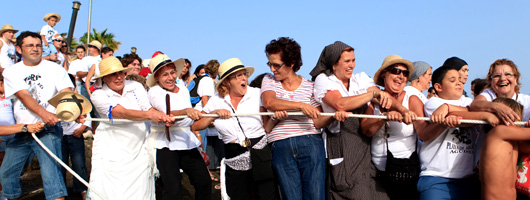
In August ‘La Vará del Pescao’ is held. This is a delightful trip through the streets of the marine town of Arinaga to the accompaniment of folk music and with fresh grilled sardines.
In May there are the Fiestas de San José Obrero, which the people of Arinaga dedicate to sharecropping and grazing activities. The agricultural and grazing tradition of the area of el Cruce de Arinaga is reflected in these festivities: the “shearing” of sheep and the “milking” of goats and cows, the making and tasting of traditional cheeses and the demonstration of traditional games and sports are some of the activities on display.
Finally, in February, Agüimes holds one of the most traditional and popular carnivals of Gran Canaria, with the day of the ‘Carnaval Antiguo’, competitions of traditional music groups and a Drag Queen competition.
In the former territory of Agüimes colonisation by the native population was intensive. It began in the first years of the modern era and gave rise to a range of settlements (dwelling caves and huts) located along the extensive network of ravines that make up the landscape of this territory.
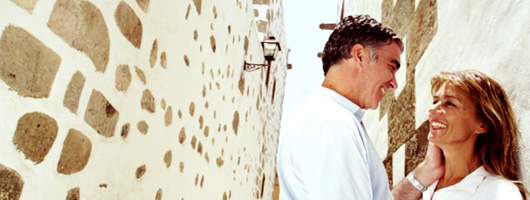
The pre-Hispanic settlements were of great importance, in particular those of Temisas and Agüimes, as can be seen in the archaeological remains found in these areas and in el Barranco de Balos and Guayadeque. This richness in human and material resources attracted the first Atlantic navigators in the middle of the fourteenth century, interested both in the slave trade and in trading orchilla lichen and sangre de drago (sap of the drago tree) for iron tools with the native chiefs.
Immediately after the conquest of Gran Canaria, the settlement of Agüimes arose around the Plaza de San Sebastián. It was quite an attractive territory, among other reasons for its ports and fishing grounds, its fields, vineyards and sugar plantations, its pastureland and commons; and for its grazing, mills and water resources – still water, springs and flowing water.
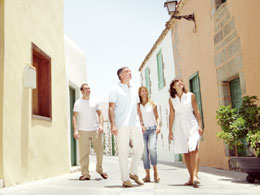
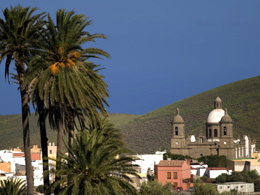
After the founding of Agüimes in 1.487, the town was ceded to the church by the Catholic Monarchs in return for the money Bishop Juan de Frías contributed to the conquest of Gran Canaria. In this way the Episcopal Assembly maintained its fiefdom for four hundred years until the Law on the Sale of Church Lands of 1.837, which ended the church ownership of this property of more than 130 kilometres of coastline extending from Gando to Maspalomas.
The municipality of Agüimes is located in the southeast of the island of Gran Canaria. It covers an area of 76 square kilometres, and it has a moderate climate with an average annual temperature of 20º and very little rainfall.
Agüimes is divided into three well-defined areas: the grazing or peak area, above 300 metres; the agricultural area at 275 metres, where the Historic Centre is also located, and the coastal area, in the region of the fishing village of Arinaga.
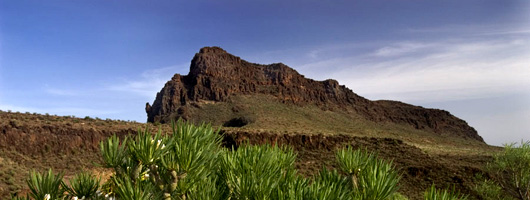
In Agüimes there is a combination of scenic beauty which includes archaeological sites of the native settlements and traditional architecture, and the marine setting that predominates throughout the coastal area.
The most significant aspect of Agüimes is in fact its landscape, with the ravine area of el Barranco de Guayadeque, the rock formation of el Roque Aguayro and the volcanic landscape of Arinaga being the main features.
From the end of the nineteenth century, and in particular throughout the twentieth century, the demand for horticultural products from the local, national and primarily the European markets meant that large expanses of the coastal area of the southeast of the island were given over to export crops. These were initially outdoor crops, such as tomatoes, although more recently the crops are grown in hothouses, and as well as tomatoes, they include cucumbers, carrots, peppers and even flowers.
There is also a tradition of industrial activities in the area, with sugar mills and plants, cereal mills, limestone kilns for the construction industry and salt for domestic consumption and for preparing salted products. In recent times this industrial specialisation has been more closely linked to the opening of the southern motorway, the proximity to the airport and the ease of connections which all of this implies, and the advantages that the Port of Arinaga represents for businesses.